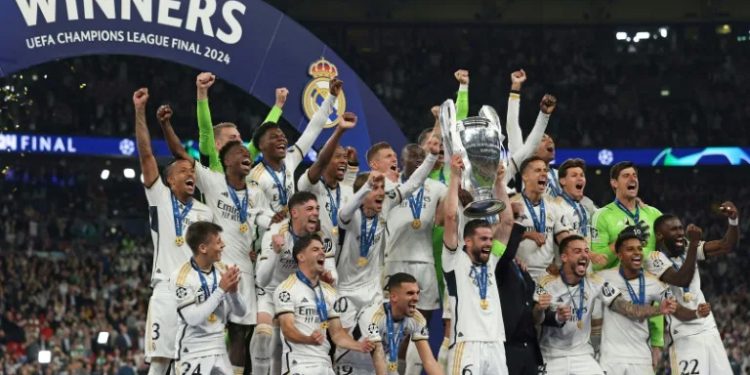UEFA needs to generate hype around the new format, because there is a risk — in the beginning at least — that fans will find it confusing compared to the old model.
For the last 21 years, the Champions League had consisted of a group stage in which 32 clubs were split into eight groups of four, each playing six games. The top two in each group qualified for the knockout phase.
The new version will feature 36 clubs with everyone playing eight matches, but all teams pooled together into one giant league rather than in groups.
Clubs will still be split into four seeded pots of nine teams, with every participant given two opponents from each pot.
The top eight in the final ranking go through to the last 16, while the next 16 sides advance to an intermediate play-off round and the remainder go out.
The new format was introduced against the backdrop of the threat by Europe’s biggest clubs to break away and form their own Super League.
But UEFA are also hoping the format can be a solution to the problem of competitive imbalance in the sport which was making the group stage more predictable.
“The new format will introduce a better competitive balance between all the teams, with the possibility for each team to play opponents of a similar competitive level throughout the league phase,” UEFA say.
– Financial rewards –
What the changes will certainly not address are concerns about too much football being played and damaging the quality as a result.
The increasing demands on players, and the lack of rest as a result, were cited as reasons why many matches at Euro 2024 proved disappointing.
The new Champions League, in a season which is also set to finish with the first expanded version of FIFA’s Club World Cup, will feature a total of 144 games in the group stage, up from 96 before.
The financial rewards are greater, however, with UEFA’s total prize pot for the Champions League rising by about 25 percent to almost 2.5 billion euros ($2.79 billion).
The winners of the competition can pocket over 86 million euros just in prize money, not including bonuses of 700,000 euros for every point gained in the league phase or income from television.
Real Madrid were the winners last season, raising the trophy for the sixth time in the last 11 years.
The addition of Kylian Mbappe to their squad means they will hope to go all the way again, and emerge victorious in the final in Munich on May 31, next year.
– Newcomers –
This season’s Champions League will include newcomers such as Girona from Spain, while Bologna of Italy take part in Europe’s elite club competition for the first time in 60 years.
Brest of France had never qualified for any European competition before, but now take part after finishing third in Ligue 1 last season — taking advantage of the extra place handed to France as the fifth-ranked league in Europe.
As for the other additional places, one goes to a national champion who will emerge from the qualifying rounds, while Italy and Germany get an extra team each because of the performances of their clubs in Europe last season.
UEFA said the draw itself will be a “hybrid” affair, between the manual drawing of balls and the use of software, having calculated that doing it all by hand would take more than three hours.
The Europa League and Conference League, the draws for which will both take place on Friday, will also now feature 36 teams, although there will be only six matches for clubs in the league phase of the latter competition.
AFP




















